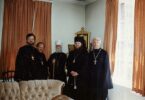From ROCOR Studies
Father Alexey Young is the author of numerous books and articles about Orthodox Christianity. Born in 1943, Fr Alexey, at the age of 27, converted from Roman Catholicism to Orthodoxy, and, in 1979, became a priest of the Russian Orthodox Church Outside of Russia (ROCOR). He and his wife, Susan, went on to have three children. After the death of his wife, Fr Alexey was tonsured and became Hieromonk Ambrose. For the last ten years, Fr Ambrose has been incapacitated by illness.
Having been the spiritual son of Fr Seraphim (Rose, d. 1982), in 2008 Fr Alexey published the widely-read Letters from Father Seraphim: The 12-Year Correspondence between Hieromonk Seraphim (Rose) & Fr Alexey Young. Among many other publications of Fr Alexey is the 136-page The Russian Orthodox Church Outside Russia: A History and Chronology which we are pleased to make available here reproducing from 1995the edition by St. Willbord Press (St. Bernardino, CA). [1] The editor has made strenuous efforts to secure permission to re-publish this document; all inquiries have failed but if anybody can help to correct this, please contact Deacon Andrei Psarev.
First published in 1993, it was reprinted during the 1990’s at least four times by the St Willibrord’s Press, an imprint of an independent Old Catholic jurisdiction in California. In the Preface, the editor of this and other books in the same series, Bishop Karl Prüter, stresses his requirement that the books “must be objective histories free of polemical material.” The bishop affirms that “Fr Alexey has given us just such a history.”
The substantive text (from 1917 to 1990) in fact comprises 12 brief chapters over less than 80 pages. However, there are some valuable appendices that list for the ROCOR clergy and parishes; monasteries and convents; schools, nursing homes, and publications, and various pertinent documents. These are followed by a brief bibliography and a comprehensive index.
The brilliance of the first Primate of the ROCOR, Metropolitan Antonii (Khrapovitskii, d. 1936) often overshadows the greatness of the second Primate of the ROCOR, Metropolitan Anastasii (Gribanovskii, d.1963), but Fr Alexey redresses this imbalance, devoting three chapters (IV-VI) to his life and work. This restores for his readership a deep appreciation of the amazing achievements of this remarkable bishop, described by Fr Alexey as “a great prelate, a true Prince of the Church in the positive sense” and as “the Russian Moses.”
Fr Alexey understood the limitations of his book. He acknowledges that his history is focused almost entirely on events and personalities within North America, necessarily ignoring after 1950 the history of the ROCOR in South America, Europe, Australia, and New Zealand. Fr Alexey lived through the so-called “Greek captivity” of the Synod of the ROCOR in the 1970s and early1980s, a painful experience for Fr Alexey and so many others of the ROCOR faithful.
On the one hand it is valuable to have a well-documented, non-polemic account of this sorry chapter in the history of the ROCOR. On the other hand, looking back, the whole unhappy occurrence (understandably) perhaps achieves an unwarranted emphasis in this history. Perhaps conscious of this imbalance, Chapter X is entitled “Spiritual Life” and chronicles devotion to the Kursk-Root Icon as well as a number of services of glorification: St Herman of Alaska (1970); Blessed Xenia of Petersburg (1978); the New Martyrs including the Royal Martyrs (1981); and Saint John of Kronstadt (1984). He also notes the decision of the ROCOR Synod to recognise the rites of the Old Believers. He speaks of the worldwide celebration of the Millennium of the Baptism of Russia in 1988. This is followed by a consideration of missionary work and the tensions which often arise between converts and ‘ethnic’ Orthodox, especially with regard to liturgical language. Finally, there is a brief account of the response of the ROCOR to the collapse of the Soviet regime and its impact on the Moscow Patriarchate in the period immediately following the events in the Soviet Union in 1990.
An assertion that a book is ‘unique’ is often an exaggerated claim. However, in the case of the History written by Fr Alexey Young, this an apt description and all who have an interest in the history of the ROCOR will learn much from a careful reading of his book.
References
| ↵1 | The editor has made strenuous efforts to secure permission to re-publish this document; all inquiries have failed but if anybody can help to correct this, please contact Deacon Andrei Psarev. |
|---|










